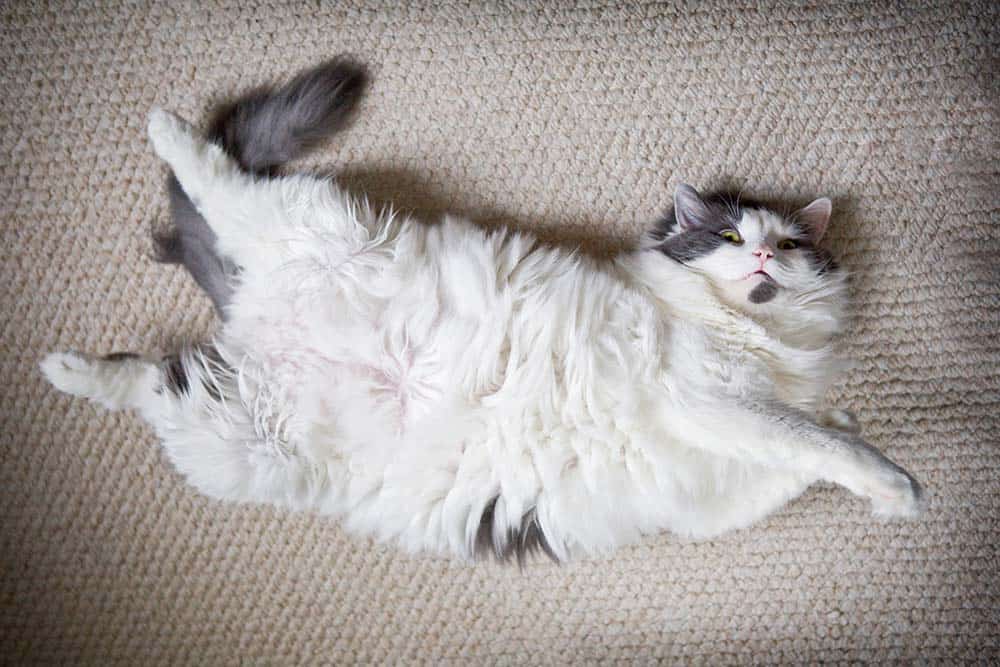Spaying and neutering cats, and dogs for that matter, has always been a super controversial topic. When to get they spayed and neuter, that it causes cancer, females should be spayed after their first heat cycle… this list continues. While the recommended age for spaying or neutering cats and dogs remain the same (between 6 and 7 months) and definitely before their first heat cycles for females, there is a new worry for pet owners about a fat pad appearing after the surgery, particularly in male cats. You may have thought this extra layer which is referred to as a post neuter fat pad is just a part of your cat’s natural saggy belly, but such is not always the case. Keep reading to learn what you need to know when it comes to a post neuter fat pad…
Dr. Jennifer Coates DVM researched the topic of why cats gain weight after their spay or neuter procedure. Her findings showed that indeed, cats did gain weight post neuter or spay. Obviously, there is a change in hormones after the procedure. However, the male cat’s energy levels did not change after their procedure. Cats were still just as active as before their reproductive parts were removed. But, their appetite increased and they ate more. In fact, their food intake increased by 50% in male cats. Because of their tremendous appetite and food consumption changed, their weight increased by 28% to 29%.
First off, what is a post neuter fat pad?
A fat pad is basically just as it sounds, it is a deposit of fat cells that have stuck together and hung out in the caudal or rear part of the abdomen. It’s possible your cat had a start of a fat pad prior to the surgery.
Is it normal?
Yes, it is normal to see male cats with fat pads. It’s even possible for your cat to have a perfect body condition score and still have that hanging pooch. Hormones can cause it to get bigger after a neuter as the surgical procedure does slow down the metabolism.
However, as your neutered cat’s appetite has increased and his metabolism as decreased, the fat can start depositing around the ribs and other parts of the body, creating a problem.
What to do about it
First things first, get Mittens on a feeding schedule and consult your veterinarian on how much he should be fed. Most cats should be fed based on their body weight. However, if Mittens is already overweight, he shouldn’t be fed for his body weight. Speak with your veterinarian about what his body condition score is. Body condition scoring (BCS) is a tool used in the veterinary field every day. The ideal BSC is 5/9. This means that ideally, Mittens should have a waist, not fat saddlebags, and his ribs should be not sticking out, but palpable.
Using a BSC chart and Mittens’ current weight, your veterinarian can educate you on what Mittens should weigh and how much he should be fed. For Mittens to lose weight, don’t be surprised if your veterinarian recommends feeding Mittens even less than what is ideal body weight would be fed.
There are also foods designed specifically to help with weight loss. We recommend Metabolic by Hill’s to many obese cat owners.
Should I still have my cat spayed or neutered?
Yes, a thousand times, yes! Breeders especially have opinions of why not to spay or neuter and the internet as well. However, spaying and neutering around 6 to 7 months of age is always a yes. And before their first heat cycle for females. In fact, if you wait until after their heat cycle, the procedure is a bit more complicated and healing time is slower.
To wrap up, remember that hormones may play a part in increasing your cat’s appetite after the spay/neuter procedure, but fat pads are normal. It’s when the fat starts padding up on other places of the body that becomes a problem. Nutrition is extremely important. You aren’t starving your cat by feeding them their required calories for the day. In fact, you are keeping them healthy and away from obesity, which can cause a lot of other health concerns.
Did you learn anything new and interesting about our feline friends? Share this article with another cat lover that you know so they can learn something, too.






